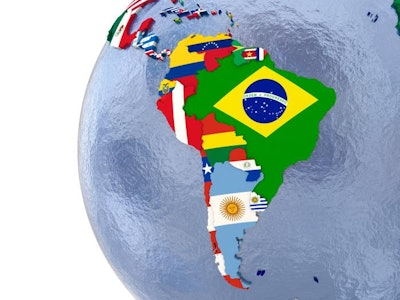
The Latin American poultry industry turned in a mixed performance in 2020. The region’s poultry companies, like most others around the world, were strongly impacted by the COVID-19, yet both chicken meat and egg producers saw output expand last year.
Data only recently made available suggest that Latin America’s broiler production measured by head slaughtered grew by 1.9% in 2020. A much stronger performance was recorded in the egg industry, with the region’s flock expanding by 4.6%. Turkey production, however, continued to contact, falling by 9.7% over the year.

Broiler production
All countries, to a greater or lesser extent, were affected by the COVID-19 pandemic. Closure or restrictions in food service had the biggest impact on broiler sales in the region, particularly at the start of the crisis, but, additionally, the closure of live bird markets, still common in Latin America, also resulted in lost sales.
Yet overall, the market rose, expanding by slightly under two percent. This growth was strongest in the region’s largest broiler producer Brazil, which saw output increase by 5.2%.
According to Industria Avícola data, a marginal increase was also reported in Argentina, which slaughtered a little over 0.1% more birds.
In those countries with smaller production volumes, Chile and Paraguay recorded 1.8% and 1.2% increases, respectively. In the case of the Dominican Republic and Venezuela, growth stood at 16.7% and 80%, respectively, with the latter, perhaps, raising a few eyebrows.
However, alongside expansion in these countries, a number of the region’s larger broiler producers saw broiler output contract last year. For example, the number of broilers slaughtered in Peru was down by 7.98%, in Colombia it fell by 5.17%, while Mexico slaughtered 3.87% fewer birds.
In various countries output was flat, for example, in Bolivia and Paraguay. Unfortunately, a number of Central American countries had failed to complete their data collection as Poultry International went to press.

Brazil, the region’s leading poultry producer, has also experienced the greatest increase in the number of birds it slaughters each year.
Layer flock grows
Where egg production is concerned, the pandemic’s impact was very different to that witnessed by broiler companies.
Egg producers became the heroes of the pandemic. As the COVID-19 hit, panic buying of eggs occurred as more people ate at home. Some egg producers re-invented themselves offering eggs through non-traditional channels, such as on-line and through home delivery.
By year end, the region’s layer flock has increased by over 22 million head.
Important egg producing countries that saw significant growth in their layer flocks last year included: Argentina, with 7% more birds, Colombia with 6.3% more, while the Peruvian flock grew by 7.6%.
Mexico’s layer flock grew by only 1.4% but, due to the size of the Mexican egg industry, this 1.4% increase – or 2.3 million birds – accounted for 13.5% of the total increase in Latin America.
Many of the Central American countries reported similar layer flock numbers last year to those reported in 2019. Again, perhaps, noteworthy, Venezuela, which reported a 27.4% decline in 2019, reports that its layer flock doubled last year.

The last five years
Broiler production in Latin American has grown steadily over the last five years. Between 2015 and 2020, the number of chickens slaughtered in the region grew by 12.8%.
Brazil was the fastest growing country over the last half decade, recording an increase of 17.3%, while Colombia grew by 11.6%, Argentina was up by 7.5%, Peru grew by 5.9% and Mexico rose by 5.6%.
Looking across the five-year period for the layer industry, the picture is very different.
The number of laying hens in the region has grown by 18.4% over the last half decade, expanding each and every year to surpass 5oo million in 2020.
The largest egg producing countries have all grown strongly. Once again, Brazil stands out, recording a 36.3% increase in its flock over the period. It is followed by Peru with a 32.4% expansion, Colombia, which expanded its flock by 23.5%, Argentina, which witnessed an 11.4% increase, while the number of layers in Mexico rose by 3.27%.
Chicken and egg consumption
Despite increases in output, per capita chicken meat consumption Latin America actually fell last year to stand at 31.2 kg, a decrease of 0.7%.
Half of the region’s countries consume above the regional average. The country with the highest per capita chicken meat consumption is Argentina. At 50 kg person, Argentinians consume 60% more than the regional average.
Peru’s per capita poultry meat consumption comes close to that of Argentina at a little under 50 kg, while Brazil and Bolivia both consume in excess of 40 kg or poultry meat per annum.
Those Latin American countries with the lowest poultry meat consumption are Venezuela, El Salvador and Uruguay, along with several of the Central American nations. Perhaps illustrative of the difference from country to country is that Argentinians consume over 40 kg of poultry meat more than Venezuelans.
While per capita poultry meat consumption may have fallen last year, egg consumption rose by 1.9% compared to 2019 – or an additional four eggs. The region’s average now stands at 212 eggs per person.

Half of the country’s in Latin America consume above the average number of eggs for the region.
Mexico continues to lead with 377 eggs per person annually, while Colombia comes second with 325 eggs. Argentinians now, on average, consume 310 eggs each.
The lowest per capita egg consumption last year was recorded by Venezuela with 76 eggs. Nicaragua fared a little better with 100 eggs and Honduras with 135 eggs.
Acknowledgments:
I am grateful for the help received from Latin America’s poultry producers' associations and experts in the region. Compiling these figures would not be possible without their hard work and selfless collaboration.
















